KTM 250 SX-F User Manual
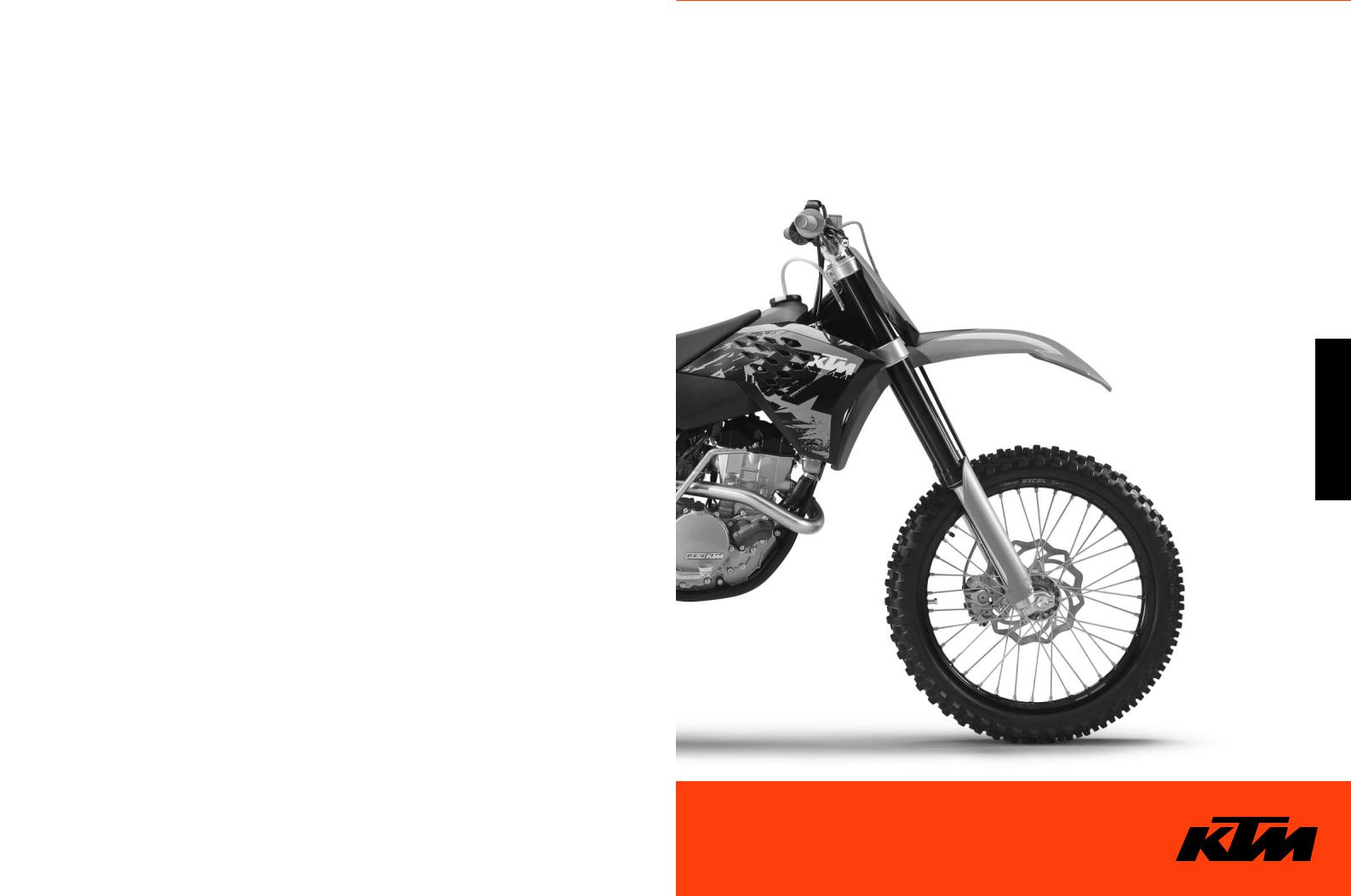
OWNER’S MANUAL 2007
250 SX-F
450 SX-F
ART. NR. 3.211.146 EN
ENGLISH
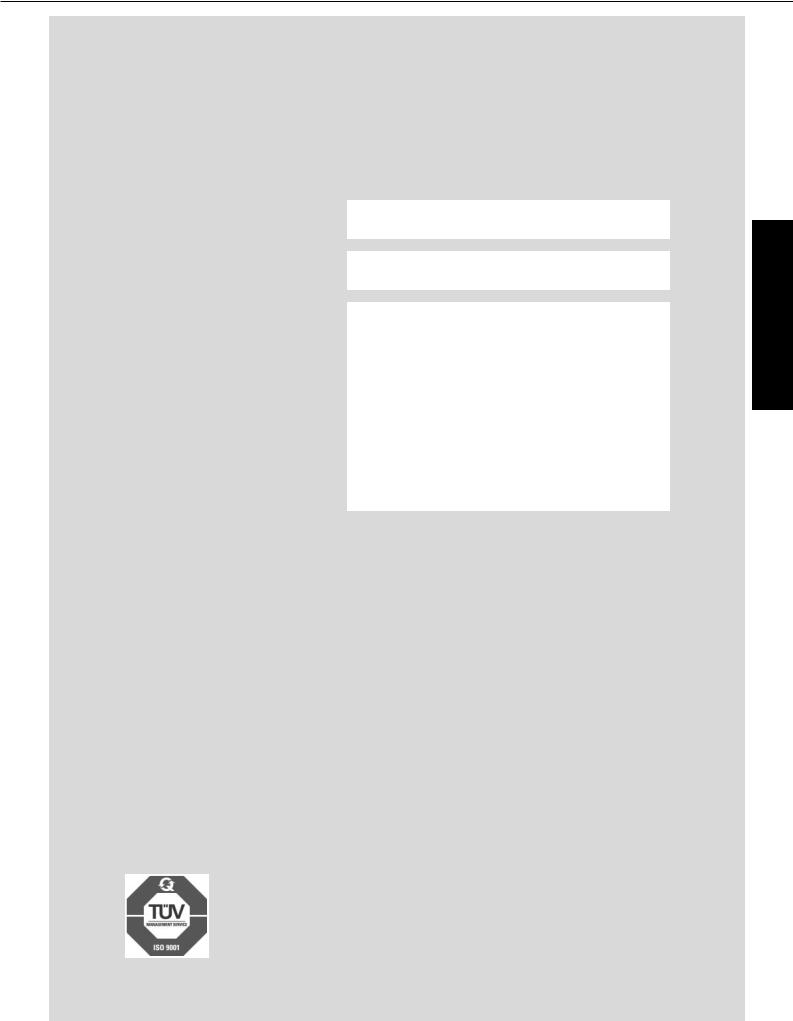
INTRODUCTION »
We would like to congratulate you on your purchase of a KTM motorcycle.
You are now the owner of a state-of-the-art sports motorcycle that guarantees to bring you lots of fun and enjoyment, provided that you clean and maintain it appropriately.
Please insert the serial numbers of your motorcycle in the boxes below
Frame number
Engine number
Stamp of dealer
COMSUMER INFORMATION FOR AUSTRALIA ONLY
Tampering with noise control system prohibited
Owners are warned that the law may prohibit:
(a)The removal or rendering inoperative by any person other than for purposes of maintenance, repair or replacement, of any device or element of design incorporated into any new vehicle for the purpose of noise control prior to its sale or delivery to the ultimate purchaser or while it is in use; and
(b)the use of the vehicle after such device or element of design has been removed or rendered inoperative by any person.
All information contained is without obligation. KTM-Sportmotorcycle AG particularly reserves the right to modify any equipment, technical specifications, prices, colors, shapes, materials, services, service work, constructions, equipment and the like so as to adapt them to local conditions or to cancel any of the above items, all without previous announcement and without giving reasons. KTM may stop manufacturing certain models without previous notice. KTM shall not be held liable for any deviations of availability and/or ability to deliver, illustrations, descriptions, printing and/or other errors. The illustrated models partly contain extra equipment, which is not applied to standard models.
© 2006 by KTM-SPORTMOTORCYCLE AG, Mattighofen AUSTRIA; All rights reserved; Reprint, also in extracts, with written allowance of KTM-SPORTMOTORCYCLE AG, Mattighofen only.
In accordance with the international quality management ISO 9001 standard, KTM uses quality assurance processes that lead to the highest possible product quality.
ENGLISH
1
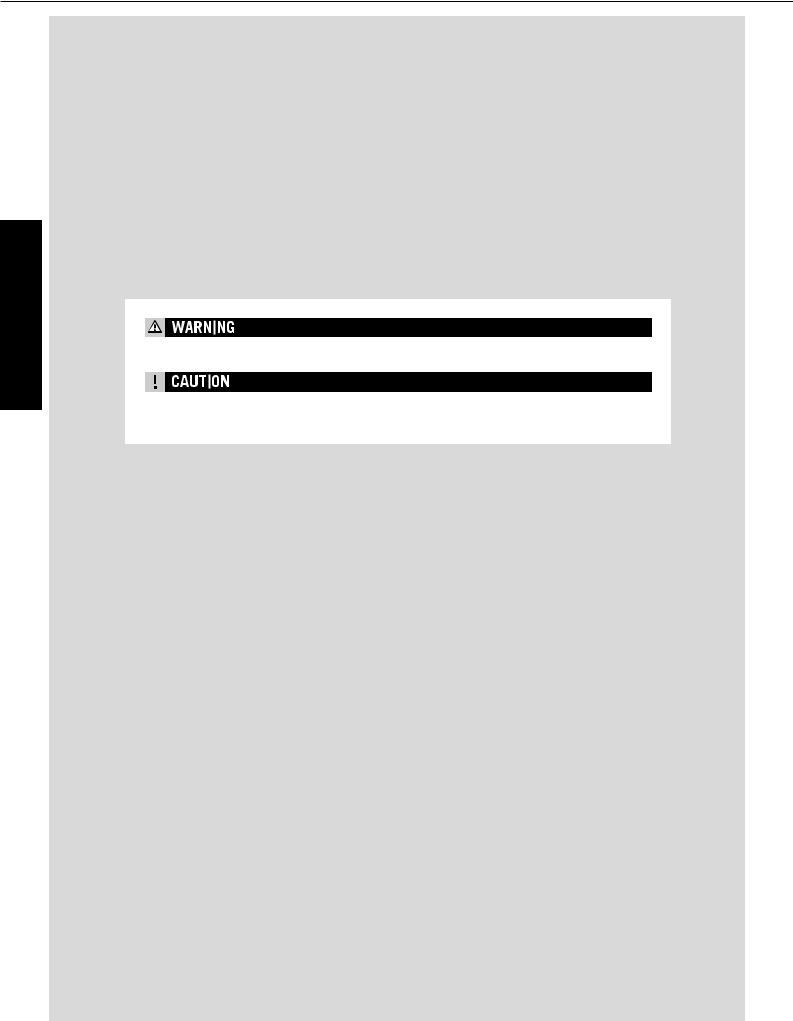
IMPORTANT »
ENGLISH
2
INTENDED PURPOSE
KTM sports motorcycles are designed and constructed to resist the usual wear and tear of normal use in competitions.
The motorcycles comply with the regulations and categories currently in effect with the leading international motorcycle associations.
OWNER’S MANUAL
Please read this manual carefully and completely before going on your first ride. It contains a great deal of information and advice which will help you use and handle your bike properly. Only by doing so will you learn how to tune your motorbike to your specific needs and how to protect yourself against injury. Besides, this manual contains important information on motorcycle maintenance.
In your own interest, please pay particular attention to notices that are marked as follows:
–Ignoring these instructions can be dangerous to life and limb!
–Ignoring these instructions may damage parts of the motorcycle or impair the motorcycle’s traffic safety!
At the time this manual was typeset, it was up-to-date with the latest state of this production series. It cannot be completely ruled out, however, that minor discrepancies may exist resulting from further design upgrades of these motorcycles.This manual is an important part of your motorbike and should be passed on to any subsequent owner in case you decide to sell it.
SERVICE
Observance of the service, maintenance and tuning instructions for the engine and chassis specified in the Owner's Manual is a prerequisite for faultless operation and the avoidance of premature wear. An improperly tuned chassis can lead to damage and breakage of the chassis components (see chapter on checking the basic chassis setting).
The use of the motorcycle under extreme conditions, e.g. on extremely muddy and wet terrain, can lead to higher than average wear on components such as the drive train or the brakes. In this case it may become necessary to service or replace wear parts before the service limit specified in the maintenance schedule has been reached.

IMPORTANT »
The service work specified in the "Lubrication and Maintenance Schedule" must be performed by a KTM workshop and recorded in the service manual otherwise claims under the warranty shall become void. The fuels and lubricants specified in the Owner's Manual or automotive fluids with equivalent specifications must be used in accordance with the maintenance schedule.
Take special care to follow the recommended run in, inspection, and maintenance intervals. Heeding these guidelines will significantly increase the life of your motorcycle.
WARRANTY
The service work specified in the "Lubrication and Maintenance Schedule" must be performed by a KTM workshop and recorded in the service manual otherwise claims under the warranty shall become void. No claims can be filed under the warranty for damage or consequential damage caused by manipulations or conversions to the motorcycle.
AUTOMOTIVE FLUIDS
The fuels and lubricants specified in the Owner's Manual or automotive fluids with equivalent specifications must be used in accordance with the maintenance schedule.
SPARE PARTS, ACCESSORIES
For your own safety, use KTM-approved parts and accessories only. KTM is not liable for damage that arises in connection with the use of other products.
TRANSPORT
When transporting your motorcycle, secure it with elastic straps or other mechanical devices in an upright position. Be sure that the fuel tap is closed. If the motorcycle topples over, fuel can flow out of the carburetor or fuel tank
ENVIRONMENT
Offroad-Motorcycle driving is a wonderful sport and we hope that you will be able to enjoy it to the full. It may, however, involve potential problems for the environment or lead to conflicts with others. These problems or conflicts can be avoided if the motorcycle is used responsibly. To safeguard the future of motorcycle sports, make sure that you use the motorcycle in accordance with the law, show that you are environmentally conscious and respect the rights of others.
Enjoy driving your motorcycle !
KTM-SPORTMOTORCYCLE AG 5230 MATTIGHOFEN, AUSTRIA
Attachments: Spare parts manual chassis & engine
ENGLISH
3

|
TABLE OF CONTENTS » |
|
|
|
|
|
Page |
|
IMPORTANT INFORMATION . . . . . . . . . . . . . . . . |
. . |
. . . .2 |
|
SERIAL NUMBER LOCATIONS . . . . . . . . . . . . . . |
. . |
. . . .5 |
|
Chassis number . . . . . . . . . . . . . . . . . . . . . . |
. . |
. . . .5 |
|
Engine number, engine type . . . . . . . . . . . . . . |
. . |
. . . .5 |
|
OPERATION INSTRUMENTS . . . . . . . . . . . . . . . |
. . |
. . . .5 |
|
Clutch lever . . . . . . . . . . . . . . . . . . . . . . . . . |
. . |
. . . .5 |
|
Hot start lever . . . . . . . . . . . . . . . . . . . . . . . . |
. . |
. . . .5 |
|
Hand brake lever . . . . . . . . . . . . . . . . . . . . . . |
. . |
. . . .6 |
|
Short circuit button . . . . . . . . . . . . . . . . . . . . |
. . |
. . . .6 |
|
Starter button (450 SX-F) . . . . . . . . . . . . . . . |
. . |
. . . .6 |
|
Filler cap . . . . . . . . . . . . . . . . . . . . . . . . . . . |
. . |
. . . .6 |
|
Fuel tap . . . . . . . . . . . . . . . . . . . . . . . . . . . . |
. . |
. . . .6 |
|
Choke . . . . . . . . . . . . . . . . . . . . . . . . . . . . . |
. . |
. . . .7 |
|
Shift lever . . . . . . . . . . . . . . . . . . . . . . . . . . |
. . |
. . . .7 |
ENGLISH |
|
|
|
|
Kickstarter (250 SX-F) . . . . . . . . . . . . . . . . . . |
. . . |
. . .7 |
|
Foot brake pedal . . . . . . . . . . . . . . . . . . . . . . |
. . . |
. . .7 |
|
Plug in stand . . . . . . . . . . . . . . . . . . . . . . . . |
. . . |
. . .7 |
|
Compression damping of fork . . . . . . . . . . . . . |
. . . |
. . .8 |
|
Rebound damping of fork . . . . . . . . . . . . . . . . |
. . . |
. . .8 |
|
Compression damping of shock absorber . . . . . |
. . . |
. . .8 |
|
Rebound damping of shock absorber . . . . . . . . |
. . . |
. . .9 |
4 |
GENERAL TIPS AND WARNINGS FOR STARTING THE |
||
|
MOTORCYCLE . . . . . . . . . . . . . . . . . . . . . . . . . |
. . . |
. .10 |
|
Instructions for initial operation . . . . . . . . . . . |
. . . |
. .10 |
|
Running in the Racing models . . . . . . . . . . . . . |
. . |
. .10 |
|
DRIVING INSTRUCTIONS . . . . . . . . . . . . . . . . . . |
. . |
. .11 |
|
Check the following before each start . . . . . . . . |
. . |
. .11 |
|
Starting when the engine is cold . . . . . . . . . . . . |
. . |
. .12 |
|
Starting when the engine is warm . . . . . . . . . . . |
. . |
. .12 |
|
What to do when the engine is "flooded" . . . . . . |
. . |
. .12 |
|
Starting off . . . . . . . . . . . . . . . . . . . . . . . . . . . |
. . |
. .13 |
|
Shifting/Riding . . . . . . . . . . . . . . . . . . . . . . . . |
. . |
. .13 |
|
Braking . . . . . . . . . . . . . . . . . . . . . . . . . . . . . |
. . |
. .13 |
|
Stopping and parking . . . . . . . . . . . . . . . . . . . . |
. . |
. .13 |
|
Fuel . . . . . . . . . . . . . . . . . . . . . . . . . . . . . . . . |
. . |
. .13 |
|
PERIODIC MAINTENANCE . . . . . . . . . . . . . . . . . . |
. . |
. .14 |
|
MAINTENANCE WORK ON CHASSIS AND ENGINE . . . .16 |
||
|
Changing the spring preloading of the shock absorber .16 |
||
|
Pivot bearing . . . . . . . . . . . . . . . . . . . . . . . . . |
. . |
. .16 |
|
Basic suspension setup for the weight of the driver . |
. .17 |
|
|
Checking the shock absorber and spring . . . . . . |
. . |
. .17 |
|
Determining the static sag of the shock absorber |
. . . .17 |
|
|
Determining the riding sag of the shock absorber . . . .17 |
||
|
Checking the basic setup of the telescopic fork |
. . . . .18 |
|
|
Changing the spring preload on the telescopic fork . |
. .18 |
|
|
Replacing fork springs . . . . . . . . . . . . . . . . . . . |
. . |
. .18 |
|
Breather plug front fork . . . . . . . . . . . . . . . . . . |
. . |
. .18 |
|
Cleaning the dust sleeves of the telescopic fork |
. . . . .18 |
|
|
Changing the fork offset (caster) . . . . . . . . . . . . |
. . |
. .19 |
|
Checking and adjusting the steering head bearing |
. . .20 |
|
|
Checking the throttle cable installation . . . . . . . |
. . |
. .20 |
|
How to change the handlebar position . . . . . . . . |
. . |
. .21 |
|
Check chain tension . . . . . . . . . . . . . . . . . . . . |
. . |
. .21 |
|
Correct chain tension . . . . . . . . . . . . . . . . . . . . |
. . |
. .22 |
|
Adapting the chain guide to the number of rear |
|
|
|
sprocket teeth . . . . . . . . . . . . . . . . . . . . . . . . . |
. . |
. .22 |
|
Chain maintenance . . . . . . . . . . . . . . . . . . . . . |
. . |
. .23 |
|
Chain wear . . . . . . . . . . . . . . . . . . . . . . . . . . . |
. . |
. .23 |
|
General information about KTM disc brakes . . . . |
. . |
. .24 |
|
Adjusting the free travel at the hand brake lever . |
. . |
. .25 |
|
|
Page |
Checking the brake fluid level - front brake . . . . |
. . |
. .25 |
Refilling the front brake fluid reservoir . . . . . . . |
. . |
. .25 |
Checking the front brake pads . . . . . . . . . . . . . |
. . |
. .25 |
Replacing the front brake pads . . . . . . . . . . . . . |
. . . |
.26 |
Checking the rear brake fluid level . . . . . . . . . . |
. . . |
.26 |
Refilling the rear brake fluid reservoir . . . . . . . . |
. . . |
.26 |
Changing the basic position of the foot brake pedal |
. .27 |
|
Checking the rear brake pads . . . . . . . . . . . . . . |
. . . |
.27 |
Replacing the rear brake pads . . . . . . . . . . . . . |
. . . |
.27 |
Dismounting and mounting the front wheel . . . . |
. . . |
.28 |
Dismounting and mounting the rear wheel . . . . . |
. . . |
.29 |
Checking spoke tension . . . . . . . . . . . . . . . . . . |
. . . |
.29 |
Tires, air pressure . . . . . . . . . . . . . . . . . . . . . . |
. . . |
.30 |
Battery (450 SX-F) . . . . . . . . . . . . . . . . . . . . . |
. . . |
.30 |
Charging the battery (450 SX-F) . . . . . . . . . . . . |
. . . |
.31 |
Fuse (450 SX-F) . . . . . . . . . . . . . . . . . . . . . . . |
. . . |
.31 |
Cooling system . . . . . . . . . . . . . . . . . . . . . . . . |
. . . |
.32 |
Checking the coolant level . . . . . . . . . . . . . . . . |
. . . |
.32 |
Bleeding the cooling system . . . . . . . . . . . . . . . |
. . . |
.32 |
Replacing the glassfiber yarn packing of the silencer |
.33 |
|
Cleaning the air filter . . . . . . . . . . . . . . . . . . . . |
. . . |
.34 |
Adjusting the throttle cables . . . . . . . . . . . . . . . |
. . . |
.34 |
Changing the original position of the clutch lever |
. . . .35 |
|
Checking the oil level of the hydraulic clutch . . |
. . . |
.35 |
Bleeding of the hydraulic clutch . . . . . . . . . . . . |
. . . |
.35 |
Carburetor - Adjust idling . . . . . . . . . . . . . . . . . |
. . . |
.36 |
Basic information on carburetor wear . . . . . . . . |
. . . |
.36 |
Checking the float level (float height) . . . . . . . . |
. . . |
.36 |
Draining the float chamber of the carburetor . . . |
. . . |
.37 |
Checking the engine oil level . . . . . . . . . . . . . . |
. . . |
.37 |
Engine oil . . . . . . . . . . . . . . . . . . . . . . . . . . . . |
. . . |
.38 |
Changing the engine oil . . . . . . . . . . . . . . . . . . |
. . . |
.38 |
Changing the oil filter . . . . . . . . . . . . . . . . . . . |
. . . |
.39 |
TROUBLESHOOTING . . . . . . . . . . . . . . . . . . . . . |
. . . |
.40 |
CLEANING . . . . . . . . . . . . . . . . . . . . . . . . . . . . . |
. . . |
.42 |
STORAGE . . . . . . . . . . . . . . . . . . . . . . . . . . . . . . |
. . . |
.42 |
TECHNICAL DATA - ENGINE . . . . . . . . . . . . . . . . |
. . . |
.43 |
TECHNICAL DATA - CHASSIS . . . . . . . . . . . . . . . . |
. . . |
.44 |
HEAD WORK INDEX . . . . . . . . . . . . . . . . . . . . . . |
. . . |
.47 |
WIRING DIAGRAM . . . . . . . . . . . . . . . . . . . . . . . |
appendix |
|
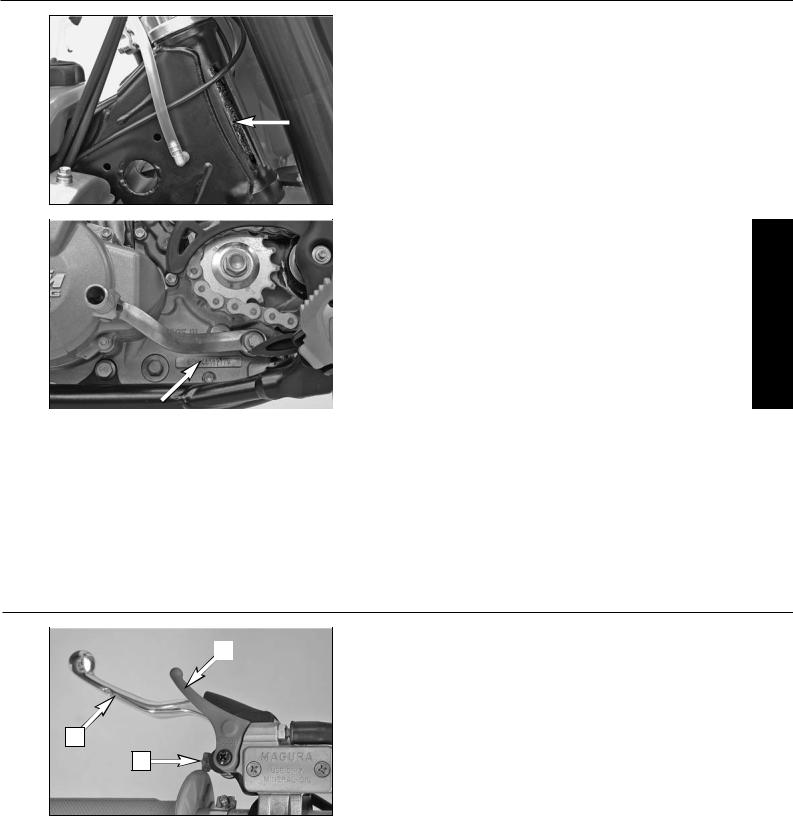
SERIAL NUMBER LOCATIONS »
Chassis number
The chassis number is stamped on the right side of the steering head tube.
Enter this number in the field on page no 1.
Engine number, engine type
The engine number and the engine type are stamped into the left side of the engine below the engine sprocket. Enter this number on page 1.
ENGLISH
5
OPERATION INSTRUMENTS »
|
|
|
Clutch lever |
|
|
|
|
|
2 |
|
The clutch lever [1] is located on the left side of the handlebar. The adjusting |
|
|
|
screw [A] is used to change the original position of the clutch lever (see |
|
|
|
maintenance work on chassis and engine). |
|
|
|
The clutch is hydraulically actuated and adjusts itself automatically. |
1
A
Hot start lever
If you pull the red hot start lever [2] during the starting procedure backward, a bore in the carburetor will be opened through which the engine may take in additional air. The result is a “lean“ fuel-air mixture of the type needed for hot starts.
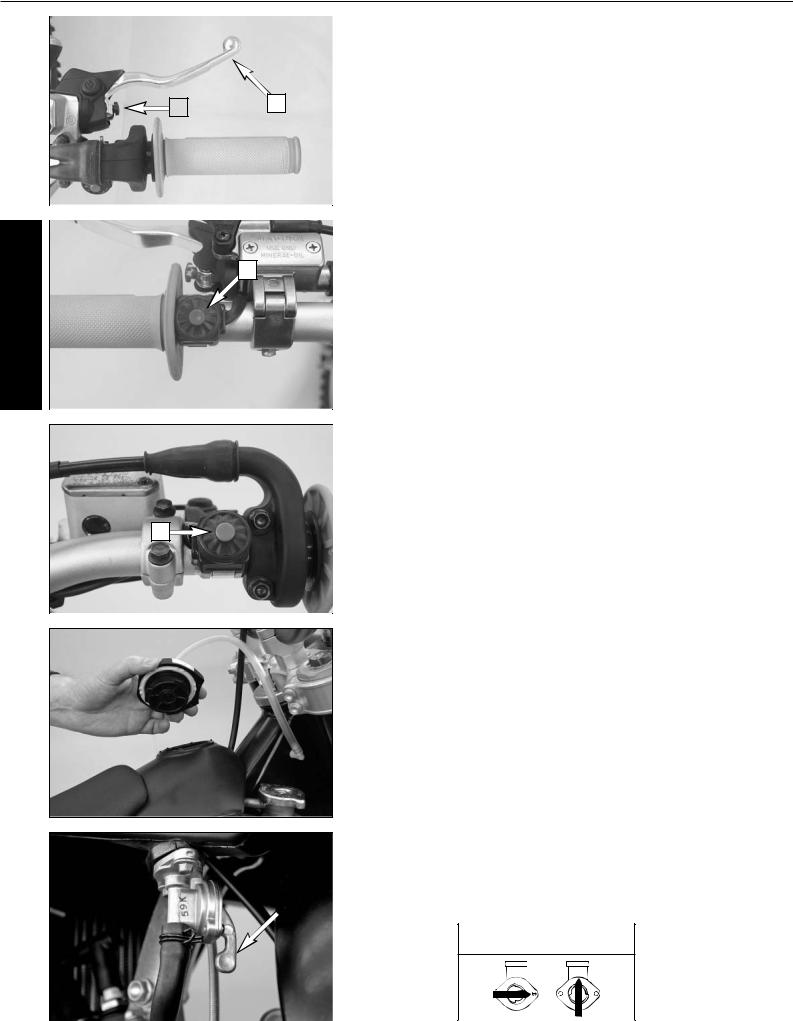
ENGLISH
6
OPERATION INSTRUMENTS »
Hand brake lever
The hand brake lever [1] is mounted on the handlebars on the right and actuates the front wheel brake. The adjusting screw [A] can be used to change the basic position of the hand brake lever (see "Maintenance").
|
1 |
A |
Short circuit button
The short circuit button [2] turns off the engine. When pressing this button,
the ignition circuit is short-circuited.
2
Starter button (450 SX-F)
 Pushing the black starter button [3] will actuate the E-starter.
Pushing the black starter button [3] will actuate the E-starter.
3
Filler cap
To open the filler cap: Turn the filler cap 45° counter-clockwise.
To close the filler cap: Put the filler cap on and turn it 45 ° clockwise.
Fuel tap
OFF In this position the fuel tap is closed. No fuel can flow to the carburetor.
ON During operation the twist grip must be turned to ON. This means that the fuel can flow to the carburetor.
OFF ON
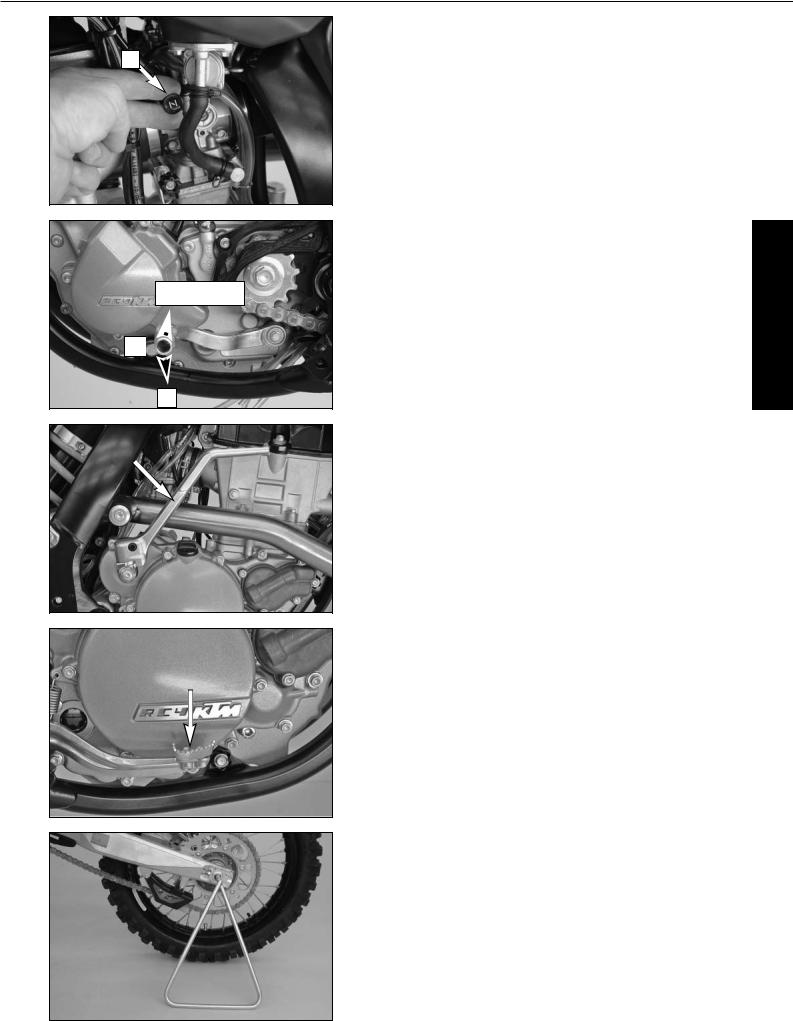
OPERATION INSTRUMENTS »
1
2,3,4 (5,6)
N 

Choke
If you pull the choke button [1] out as far as possible, a bore in the carburetor will be opened through which the engine may take in additional fuel. The result is a “fat“ fuel-air mixture of the type needed for cold starts.
To deactivate the choke, push the choke button back into its basic position.
Shift lever
The shift lever is mounted on the left side of the engine. The position of the gears is shown in the illustration. Neutral is located between first and second gear.
1
Kickstarter (250 SX-F)
The kickstarter is mounted on the right side of the engine. Its upper part can be swivelled.
Foot brake pedal
The foot brake pedal is located in front of the right footrest. Its basic position can be adjusted to your seat position (see maintenance work).
Plug in stand
ENGLISH
7
The plug-in stand can be attached to the wheel spindle on the left side of the motorcycle.
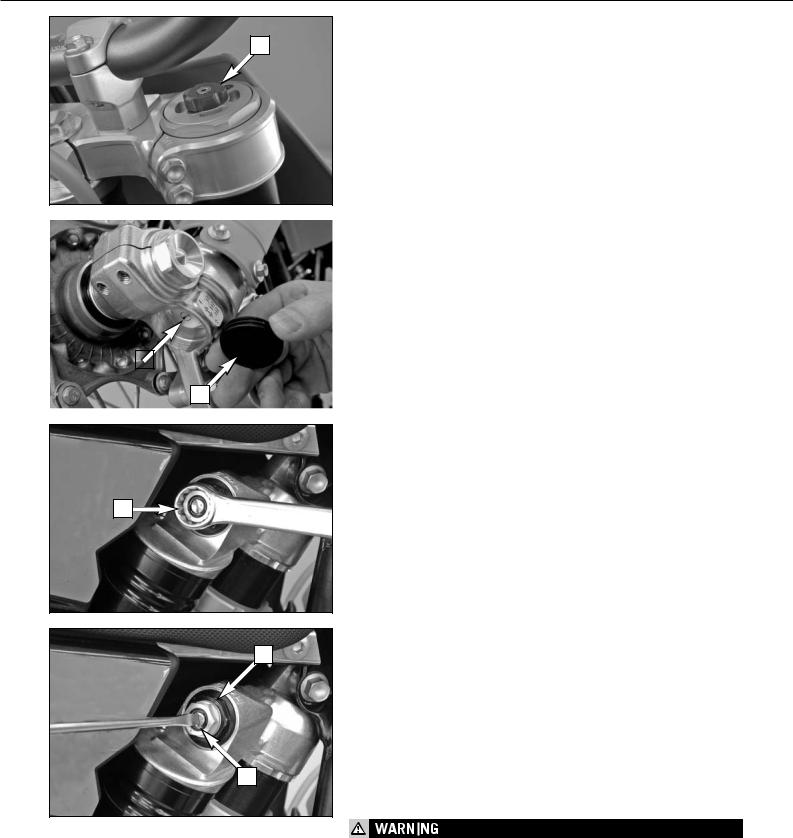
OPERATION INSTRUMENTS »
1
ENGLISH |
|
|
|
|
|
|
|
|
|
|
|
|
3 |
|
8 |
|
2 |
||
|
|
|
|
|
4
6
5
Compression damping of fork
Hydraulic compression damping determines the reaction when the fork is compressed. The degree of compression can be adjusted with adjusting screws at the top of the fork legs.
Turn the adjusting screws [1] clockwise to increase damping, turn it counterclockwise to reduce damping during compression.
STANDARD ADJUSTMENT
–turn adjusting screw clockwise as far as it will go
–turn it back by as many clicks as are specified for the relevant type of fork
WP 14.18.7C.03: 15 clicks
WP 14.18.7C.05: 15 clicks
Rebound damping of fork
Hydraulic rebound damping determines the reaction when the fork is rebound. Remove the protecting cap [2].
By turning the adjusting screw [3] (REB), the degree of damping of the rebound can be adjusted. Turn the knob clockwise to increase damping, turn it counterclockwise to reduce damping during rebounding.
STANDARD ADJUSTMENT
–turn adjusting screw clockwise as far as it will go
–turn it back by as many clicks as are specified for the relevant type of fork
WP 14.18.7C.03: 20 clicks
WP 14.18.7C.05: 21 clicks
Damping action during compression of shock absorber
The shock absorber can synchronize the compression damping in the low and high-speed range separately (Dual Compression Control).
Low and high speed refers to the movement of the shock absorber during compression and not to the speed of the motorcycle.
The low and high-speed technology overlaps.
The low-speed setting is primarily for slow to normal shock absorber compression rates.
The high-speed setting is effective at fast compression rates.
Turning in a clockwise direction will increase the damping, turning counterclockwise will decrease the damping.
STANDARD HIGH-SPEED SETTING:
–turn the adjusting screw [4] to the limit in a clockwise direction using a box wrench.
–unscrew the respective number of turns for the specific type of shock absorber in a counterclockwise direction.
WP 12.18.7C.03: 1 turn
WP 12.18.7C.05: 1 turn
STANDARD LOW-SPEED SETTING:
–turn the adjusting screw [5] to the limit in a clockwise direction using a screwdriver .
–unscrew the respective number of clicks for the specific type of shock absorber in a counterclockwise direction.
WP 12.18.7C.03: 15 clicks
WP 12.18.7C.05: 15 clicks
The damping unit of the shock absorber is filled with high-compression nitrogen. Never try to take the shock absorber apart or to do any maintenance work yourself. Severe injuries could be the result.
Never unscrew the black screw connection [6] (24mm).
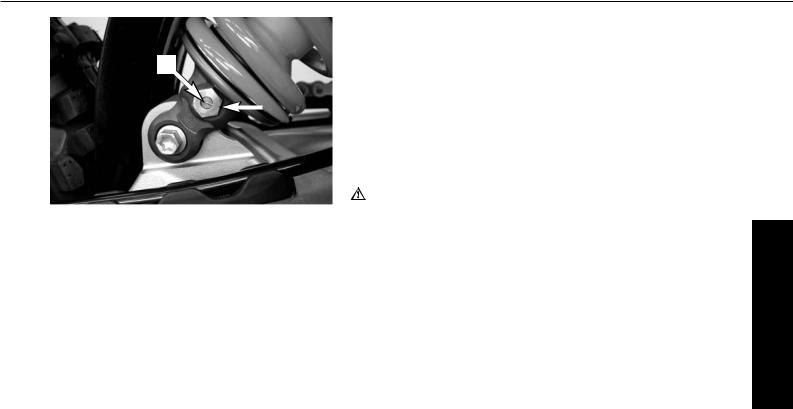
OPERATION INSTRUMENTS »
|
|
|
|
|
|
Rebound damping of shock absorber |
||||
|
|
|
|
|
|
|||||
|
|
|
|
|
|
By using the adjusting screw [1], the degree of damping of the rebound can |
||||
|
|
|
|
|
|
be adjusted. Turn the knob clockwise to increase damping, turn it counter- |
||||
|
1 |
|
|
|
|
clockwise to reduce damping during rebounding. |
||||
|
|
|
|
|
|
STANDARD ADJUSTMENT: |
||||
|
|
|
|
2 |
|
|
– |
turn the adjusting screw clockwise to the stop. |
||
|
|
|||||||||
|
|
|||||||||
|
|
|
|
|
|
|
– |
then turn the adjusting screw counterclockwise, counting the number of |
||
|
|
|
|
|
|
|
||||
|
|
|
|
|
|
|
|
clicks that corresponds to the respective type of shock absorber. |
||
|
|
|
|
|
|
|
|
|
WP 12.18.7C.03: 25 clicks |
|
|
|
|
|
|
|
|
|
|
WP 12.18.7C.05: 25 clicks |
|
|
|
|
|
|
|
|
|
|||
|
|
|
|
|
|
|
|
|
|
|
|
|
|
|
|
|
The damping unit of the shock absorber is filled with high-compression |
||||
|
|
|
|
|
|
nitrogen. Never try to take the shock absorber apart or to do any maintenance |
||||
|
|
|
|
|
|
work yourself. Severe injuries could be the result. |
||||
|
|
|
|
|
|
Never unscrew the screw connection [2] (15mm). |
||||
ENGLISH
9
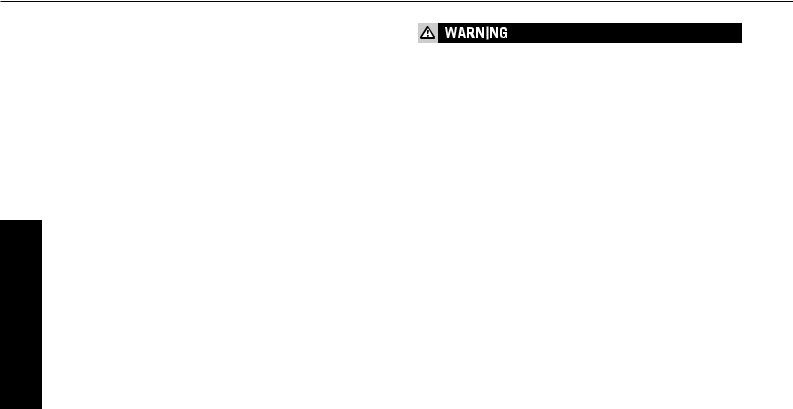
ENGLISH
10
GENERAL TIPS AND WARNINGS FOR STARTING THE MOTORCYCLE »
Instructions for initial operation
–Make sure the work for the “pre-delivery inspection“ was performed by your authorized KTM workshop. The DELIVERY CERTIFICATE and SERVICE MANUAL will be handed over when you pick up your vehicle.
–Read these operating instructions carefully before your first ride.
–Familiarize yourself with the operating elements.
–Set the clutch lever, the handbrake lever, and the footbrake pedal to the positions that are most convenient for you.
–Get used to handling the motorcycle on an empty parking lot or open space, before starting on a longer drive. Also try to drive as slowly as possible and in a standing position, to improve your feeling for the vehicle.
–Do not drive along off-road tracks which go beyond your ability and experience.
–Hold the handlebars with both hands and leave your feet on the foot rests while driving.
–Remove your foot from the foot brake lever when you are not braking. If the foot brake lever is not released the brake pads rub continuously and the braking system is overheated.
–Do not make any alterations to the motorcycle and always use ORIGINAL KTM SPARE PARTS. Spare parts from other manufacturers can impair the safety of the motorcycle.
–Motorcycles are sensitive to alterations in the distribution of weight. If you are taking luggage with you, this should be secured as close as possible to the middle of the vehicle; distribute the weight evenly between the front and rear wheel. Never exceed the maximum permissible laden weight and the axle weights. The maximum permissible laden weight is comprised of the following components:
–Motorcycle ready for operation and tank full
–Driver with protective clothing and helmet.
–Pay attention to the running-in procedure.
–Dress properly for the ride. Smart KTM drivers always wear a helmet, boots, gloves and the right Enduro/Motocross clothing. Protective clothing should be conspicuous to make sure other road users see you in time.
–Do not drive after drinking alcohol.
–Always switch on the light while driving to make sure other road users see you in time.
–Only use accessories approved by KTM.
–Always use front and rear tires with the same tread pattern.
–The 250/450 SX-F models are designed and built for 1 person only. No passengers are permitted.
–Adjust your speed to the conditions and your driving skill.
–Drive cautiously on unfamiliar roads or in unfamiliar terrain.
–Always have a friend accompany you on his bike when driving off road so you can help each other if you run into trouble.
–Replace the helmet visor or the lenses in your glasses in time. A scratched visor or scratched lenses can make you practically blind in back light.
–Never leave your motorcycle running unattended.
–250/450 SX-F models are not permitted on public roads and highways.
–When riding your motorcycle, please remember that excessive noise may disturb others.
Running in
Even very precisely machined sections of engine components have rougher surfaces than components which have been sliding across one another for quite some time. Therefore, every engine needs to be broken in.
For this reason, do not load the engine more than 50% of its capacity during the first 3 operating hours. Besides, the engine speed must not exceed 7000 rpm. Avoid going full-throttle!
In the following 12 operating hours, you may load the engine up to 75% of its capacity.
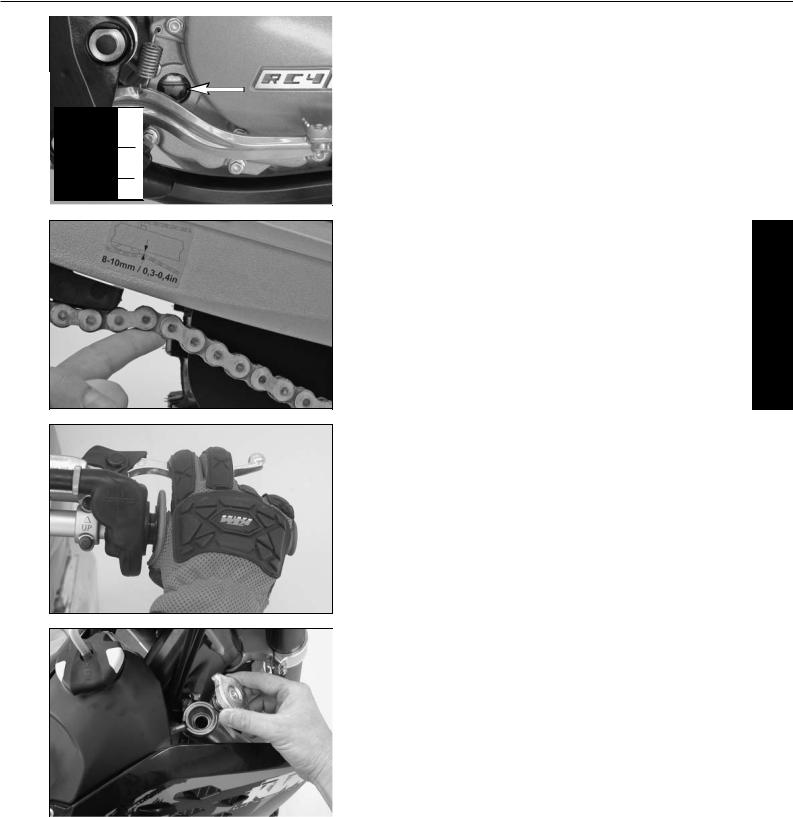
DRIVING INSTRUCTIONS » |
|
Check the following before each start |
|
When you start off, the motorcycle must be in perfect technical condition. |
|
For safety reasons, you should make a habit of performing an overall check |
|
of your motorcycle before each start. |
|
The following checks should be performed: |
|
1 CHECK THE OIL LEVEL |
|
|
Insufficient oil results in premature wear and consequently to engine |
B |
damage. |
|
|
2 |
FUEL |
A |
Check that there is sufficient fuel in the tank; when closing the filler cap, |
|
check that the tank venting hose is free of kinks. |
3 |
CHAIN |
|
A loose chain can fall from the chain wheels; an extremely worn chain can |
|
tear, and insufficient lubrication can result in unnecessary wear to the chain |
|
and chain wheels. Excessive tensioning of the chain will put additional |
|
load on the components of the secondary drivetrain (chain, bearings of |
|
transmission and rear wheel). Aside from resulting in premature wear, if |
|
worst comes to worst the chain may rupture or the countershaft of the |
|
transmission may break. |
4 |
TIRES |
|
Check for damaged tires. Tires showing cuts or dents must be replaced. |
|
The tread depth must comply with the legal regulations. Also check the |
|
air pressure. Insufficient tread and incorrect air pressure deteriorate the |
|
driving performance. |
5 |
BRAKES |
|
Check correct functioning of the braking system. Check for sufficient |
|
brake fluid in the reservoir. The reservoirs have been designed in such a |
|
way that brake fluid does not need to be refilled even when the brake pads |
|
are worn. If the level of brake fluid falls below the minimum value, this |
|
indicates a leak in the braking system or completely worn out brake pads. |
|
Arrange for the braking system to be checked by a KTM specialist, as complete |
|
failure of the braking system can be avoided. |
|
Also check the state of the brake hose and the thickness of the brake |
|
linings. |
|
Check free travel at the hand brake lever and foot brake lever. |
6 |
CABLES |
|
Check correct setting and easy running of all control cables. |
7 |
COOLING FLUID |
|
Check the level of the cooling fluid when the engine is cold. |
ENGLISH
11
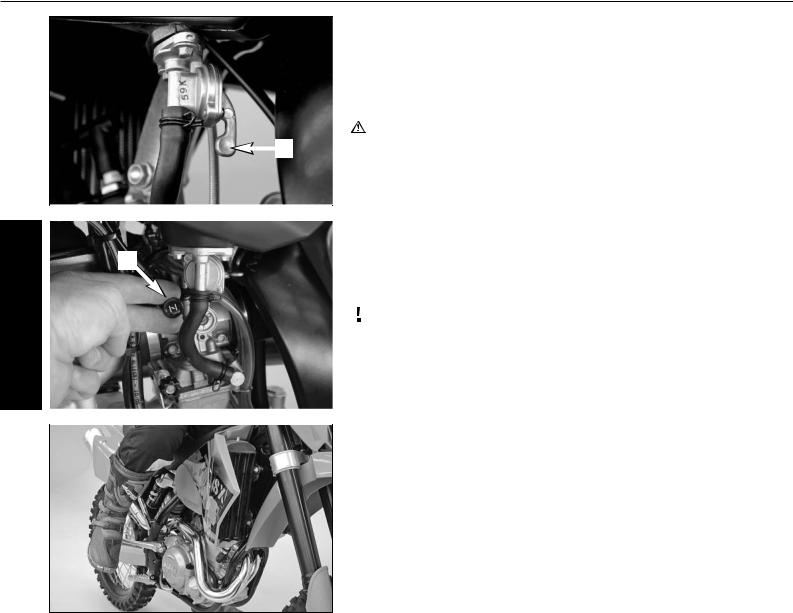
ENGLISH
12
DRIVING INSTRUCTIONS »
Starting when the engine is cold
1Open the fuel tap [1].
2Swing up the side stand or center stand.
3Put the gear in neutral.
4Operate the choke [2].
5Leave throttle closed and kick the kickstarter briskly ALL THE WAY or actuate the E-starter.
|
|
|
|
|
|
|
|
|
|
|
|
1 |
|
|
– |
If you want to start the engine, make sure that you always put on sturdy |
|||
|
|
||||||||
|
|
|
|
|
|
|
|
motorcycle boots in order to avoid injuries. You might slip off the kickstarter, |
|
|
|
|
|
|
|
|
|
||
|
|
|
|
|
|
|
|
or the engine may kick back. |
|
|
|
|
|
|
|
|
– Always kick the kickstarter briskly all the way without opening the throttle. |
||
|
|
|
|
|
|
|
|
If you do not Kick hard enought, with an open throttle grip, the kick-back |
|
|
|
|
|
|
|
|
|
hazard will be higher. |
|
|
|
|
|
|
|
|
– Do not start the engine and allow it to idle in a closed area. Exhaust fumes |
||
|
|
|
|
|
|
|
|||
|
|
|
|
|
|
|
|
are poisonous and can cause loss of consciousness and death. Always provide |
|
|
|
|
|
|
|
|
|
adequate ventilation while the engine is running. |
|
|
2 |
|
|
|
|
|
|
||
|
|
|
|
|
|
– |
Always verify that the transmission has been set to idle (neutral) before |
||
|
|
|
|
|
|
|
|||
|
|
|
|
|
|
|
|
actuating the starter button. If you start the motorcycle with a gear engaged, |
|
|
|
|
|
|
|
|
|
the motorcycle will move forward. |
|
|
|
|
|
|
|
|
|
|
|
|
|
|
|
|
|
|
|
|
|
|
|
|
|
|
|
|
– Maximal period for continuous starting: 5 seconds. Wait at least 5 seconds |
||
|
|
|
|
|
|
|
|
before trying again. |
|
|
|
|
|
|
|
|
– Don’t ride your motorcycle with full load and don’t rev up the engine when |
||
|
|
|
|
|
|
|
|
cold because the piston is warming up faster than the water cooled cylinder |
|
|
|
|
|
|
|
|
|
and can cause engine damage. |
|
|
|
|
|
|
|
NOTE: If you have trouble starting the motorcycle, this could be due to old |
|||
|
|
|
|
|
|
||||
|
|
|
|
|
|
|
|
fuel in the float chamber. The easily inflammable components of the |
|
|
|
|
|
|
|
|
|
||
|
|
|
|
|
|
|
|
new fuels evaporate during longer periods of standstill.When the |
|
|
|
|
|
|
|
|
|
motorcycle has been out of operation for more than a week, it is therefore |
|
|
|
|
|
|
|
|
|
recommended to drain the old fuel from the float chamber. The |
|
|
|
|
|
|
|
|
|
engine will immediately start off when the float chamber is filled with |
|
|
|
|
|
|
|
|
|
new fuel. |
|
Starting when the engine is warm
1Open the fuel tap [1].
2Swing up the side stand.
3Put the gear in neutral.
4Pull the hot start lever
5Leave throttle closed and kick the kickstarter briskly ALL THE WAY or actuate the E-starter.
What to do when the engine is “flooded“
The fork legs must be partly disassembled to change the spring preload (see WP manual). Pretension spacers in various thicknesses are available (see spare parts catalog).
NOTE:
The carburetor has an accelerator pump. Every time you open the throttle, fuel will be injected into the intake passage. When starting, be sure that you open the throttle completely only once.
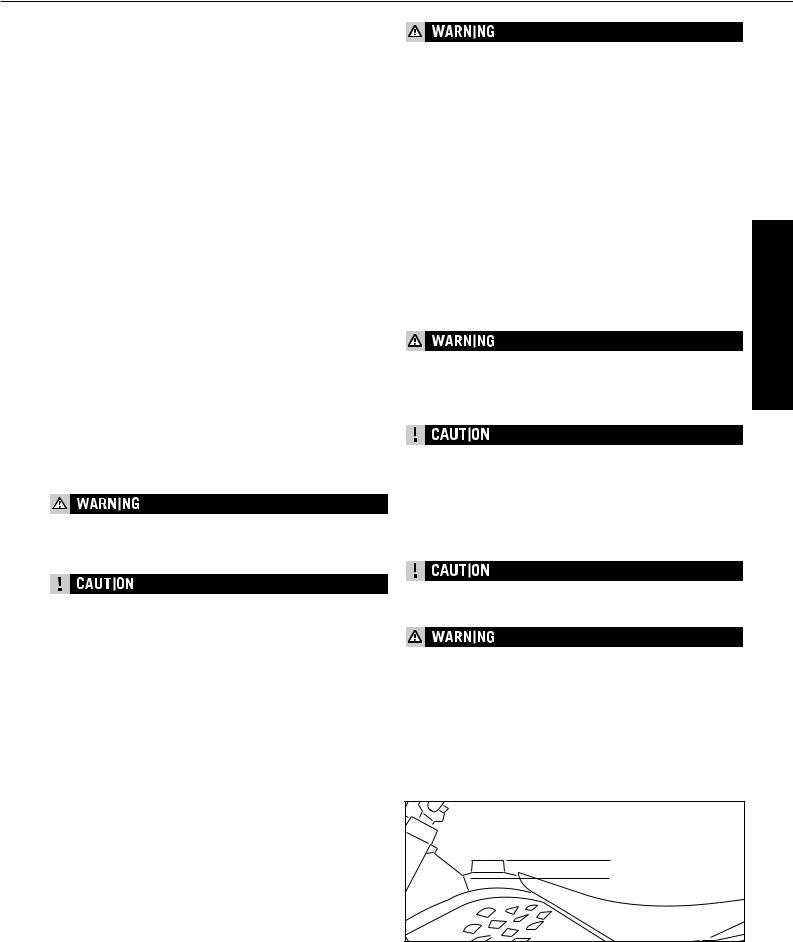
DRIVING INSTRUCTIONS »
Starting off
Pull the clutch lever. Put the engine into first gear, slowly release the clutch lever and open the throttle at the same time.
Shifting/Riding
You are now in first gear, refered to as the drive or uphill gear. Depending on the conditions (hill size etc.), you can shift to a higher gear. Close throttle, at the same time pull clutch lever in and shift to the next higher gear. Let clutch lever go again and accelerate. If you turned on the choke, make sure you turn it off again as soon as engine is warm.
When you reach full speed through opening the throttle all the way, turn throttle back to 3/4; the speed hardly decreases although the engine will use less gas. Only give as much gas as the engine can handle. Through quick and high revving of the throttle, the fuel usage increases.
By shifting down, use the brakes if necessary and close the throttle at the same time. Pull the clutch lever and shift down to the next gear. Let clutch lever go slowly and open the throttle or shift down again.
NOTE:
Dedicated to nothing but offroad racing, 250/450 SX-F-models make no compromises in their design. As such, they do not include any radiator fan, and the size of the radiator is dimensioned for optimum ergonomics.
In normal racing, the cooling system is sufficient.
If you use your motorbike in other conditions, please note that: turn off the engine if you intend to run your motorcycle in idle or at a standstill for longer periods of time (more than 2 minutes). Avoid letting the clutch slip frequently and for extended periods. This would cause the engine oil to heat up, thereby heating up the cooling system. You should drive at low speeds (4-stroke style - letting the engine pull you) and not at high speeds not by letting the clutch slip (2-stroke style).
–After falling with the motorcycle, check all functions thoroughly before starting up operations again.
–A twisted handlebar must always be replaced. Do not adjust the handlebar, it will lose stability.
–High rpm rates when the engine is cold have an adverse effect on the life of your engine. We recommend you run the engine in a moderate rpm range for a few miles giving it a chance to warm up. After that no further precautions in this respect need to be taken. The engine has reached its operating temperature as soon as the radiators become warm.
–Never have the throttle wide open when changing down to a lower gear. The engine will over-rev, damaging the valves. In addition, the rear wheel locks so that the motorcycle can easily get out of control.
–If any abnormal vibrations occur while driving, check that the engine fastening bolts are tight.
–In the event that, while riding on your motorcycle, you notice any unusual operation-related noise, stop immediately, turn the engine off, and contact an authorized KTM dealer.
–In case of rain, after washing the motorcycle, after rides through water and in case of rides on wet off-road tracks, humid or dirty brake discs can delay the braking effect. The brakes must be pulled until they are dry or clean.
–Dirty brake discs cause increased tear of brake pads and brake discs.
–When you brake, the brake discs, brake pads, brake caliper and brake fluid heat up. The hotter these parts get, the weaker the breaking effect. In extreme cases, the entire braking system can fail.
–If the resistance in the hand brake lever or foot brake pedal feels “spongy” (too much play), this is an indication that something is wrong with the brake system. Don’t ride your motorcycle anymore without first having the brake system looked over by a KTM dealer.
Stopping and parking
Apply the brakes fully and put the engine into neutral. To turn off the engine, push the short-circuit button with the engine at idling speed until the engine stops. Turn the fuel tap to the OFF position, park on an area where the ground is firm.
Motorcycle engines produce a great amount of heat while running. The engine, exhaust pipe, muffler, brake rotors, and shock absorbers can become very hot. Do not touch any of these parts after operating the motorcycle, and take care to park it where pedestrians are not likely to touch it and get burned.
–Close the fuel tap when leaving your vehicle.Otherwise the carburettor can flood and fuel will enter the engine.
–Never park your motorcycle in places where there are fire hazards due to dry grass or other easily flammable materials.
Fuel
The racing engine needs unleaded fuel with at least RON 95 (USA = Premium RON 91).
Use leaded or unleaded premium grade gasoline (95 octanes). Never use gasoline having less than 95 octanes because it may damage the engine.
Gasoline is highly flammable and poisonous. Extreme caution should be used when handling gasoline. Do not refuel the motorcycle near open flames or burning cigarettes. Always switch off the engine before refuelling. Be careful not to spill gasoline on the engine or exhaust pipe while the engine is hot. Wipe up spills promptly. If gasoline is swallowed or splashed in the eyes, seek a doctor’s advice immediately.
Fuel expands when its temperature rises. Therefore do not fill the tank to the top (see fig.).
Braking
Close throttle and apply the hand and foot brakes at the same time. When driving on sandy, wet or slippery ground use mainly the rear wheel brake. Always brake with feeling, blocking wheels can cause
you to skid or fall. Always finish braking before you enter a curve.  35 mm Also change down to lower gears depending on your speed.
35 mm Also change down to lower gears depending on your speed.
When driving down hill, use the braking effect of the engine. Change down one or two gears but do not overspeed the engine. In this way, you will not need to brake so much and the brakes will not overheat.
ENGLISH
13
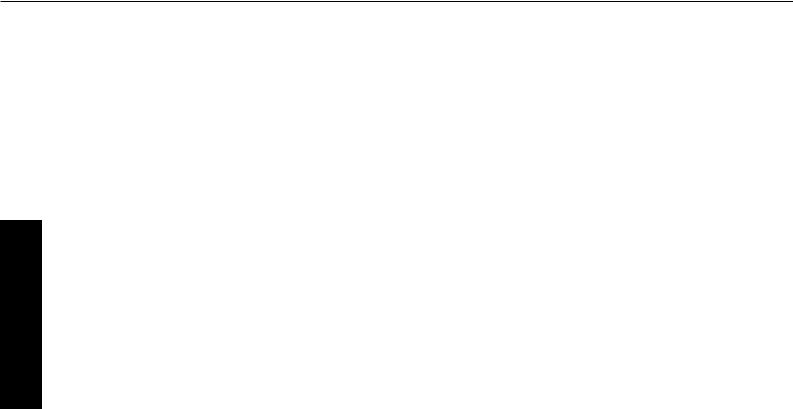
PERIODIC MAINTENANCE »
ENGLISH
14
250/450 SX-F 2007 |
1st service after |
every |
||
3 hours |
10 hours |
|||
A CLEAN MOTORCYCLE CAN BE CHECKED MORE QUICKLY WHICH SAVES MONEY! |
or |
or |
||
|
|
20 l fuel |
70 l fuel |
|
|
Change engine oil, oil filter |
z |
z |
|
|
|
|
|
|
|
Clean oil screen and drain plug magnet |
z |
z |
|
|
|
|
|
|
ENGINE |
Replace spark plug (after 30 hours) |
|
|
|
|
|
|
||
Check and adjust valve clearance |
z |
z |
||
|
||||
|
|
|
|
|
|
Check engine mounting bolts for tightness |
z |
z |
|
|
|
|
|
|
|
Clean the spark-plug connector and check for a tight fit |
z |
z |
|
|
|
|
|
|
|
Check the screws on the kick starter and shift lever for a tight fit |
z |
z |
|
|
|
|
|
|
CARBURETOR |
Check vent hoses for damage or bends |
z |
z |
|
|
Check carburetor connection boot for cracks and leaks |
|
z |
|
|
Check idle speed setting |
z |
z |
|
|
|
|
|
|
|
Check cooling system for leaks, check quantity of antifreeze |
z |
z |
|
|
|
|
|
|
PARTS |
Check exhaust system for leaks and fitment |
|
z |
|
|
|
|
||
Check cables for damage, smooth operation and bends, |
z |
z |
||
ADD-ON |
adjust and lubricate |
|
|
|
Check fluid level of the clutch master cylinder |
z |
z |
||
|
||||
|
|
|
|
|
|
Clean air filter and filter box |
|
z |
|
|
|
|
|
|
|
Check electric wires for damage and bends |
|
z |
|
|
|
|
|
|
BRAKES |
Check brake fluid level, lining thickness, brake discs |
z |
z |
|
|
|
|
||
Check brake lines for damage and leaks |
z |
z |
||
|
||||
|
|
|
|
|
|
Check/function smooth operation and adjust free travel of handbrake/foot brake lever |
z |
z |
|
|
|
|
|
|
|
Check the screws and guide bolts on the brake system for a tight fit |
z |
z |
|
|
|
|
|
|
|
Check shock absorber and fork for leaks and function |
z |
z |
|
|
|
|
|
|
|
Clean fork dust bellows |
|
z |
|
CHASSIS |
|
|
|
|
Bleed fork legs |
|
z |
||
|
|
|
||
Check swing arm bearings |
|
z |
||
|
|
|||
|
|
|
|
|
|
Check/adjust steering head bearings |
z |
z |
|
|
|
|
|
|
|
Check tightness of chassis screws (triple clamps, fork leg axle passage, |
z |
z |
|
|
swingarm, shock aborber) |
|||
|
|
|
||
|
Check/adjust steering head bearings |
z |
z |
|
|
|
|
|
|
WHEELS |
Check tires and air pressure |
z |
z |
|
|
|
|
||
Check chain, chain joint, rear sprockets and chain guides for wear, fit and tension |
z |
z |
||
|
||||
|
|
|
|
|
|
Lubricate chain, clean and grease the adjusting screws on the chain tensioner |
z |
z |
|
|
|
|
|
|
|
Check clearance of wheel bearings |
z |
z |
|
|
|
|
|
|
|
|
|
||
250/450 SX-F 2007 |
|
|
||
IMPORTANT RECOMMENDED MAINTENANCE WORK THAT CAN BE CARRIED OUT BY EXTRA ORDER |
|
|
||
|
|
at least |
every |
|
|
|
once a year |
2 years |
|
Complete maintenance of fork |
z |
|
||
|
|
|
||
Complete maintenance of shock absorber |
|
z |
||
|
|
|
||
Clean and grease steering head bearings and gasket elements |
z |
|
||
|
|
|
||
Clean and adjust carburetor |
z |
|
||
|
|
|
||
Treat electric contacts and switches with contact spray |
z |
|
||
|
|
|
||
Change hydraulic clutch fluid |
z |
|
||
|
|
|
||
Change brake fluid |
z |
|
||
|
|
|
|
|
IF MOTORCYCLE IS USED FOR COMPETITION 10 HOURS SERVICE SHOULD BE CARRIED OUT AFTER EVERY RACE. Service intervalls should never be exceeded by more than 2 hours or 15 liters of fuel.
Maintenance work done by KTM authorised workshops is not a substitute for care and checks done by the rider.

PERIODIC MAINTENANCE »
250/450 SX-F 2007
IMPORTANT CHECKS AND MAINTENANCE TO BE CARRIED OUT BY THE RIDER
|
Before |
After |
For cross- |
at least |
|
|
each |
|
every |
country |
once |
|
start |
|
cleaning |
use |
a year |
Check oil level |
|
z |
|
|
|
|
|
|
|
|
|
Check brake fluid level |
|
z |
|
|
|
|
|
|
|
|
|
Check brake pads for wear |
|
z |
|
|
|
|
|
|
|
|
|
Lubricate and adjust cables and nipples |
|
|
z |
|
|
|
|
|
|
|
|
Bleed fork legs regularly |
|
|
|
z |
|
Remove and clean fork dust bellows regularly |
|
|
|
z |
|
Clean and lubricate chain, check tension and adjust if necessary |
|
|
z |
z |
|
|
|
|
|
|
|
Clean air filter and filter box |
|
|
|
z |
|
|
|
|
|
|
|
Check tires for pressure and wear |
|
z |
|
|
|
|
|
|
|
|
|
Check cooling fluid level |
|
z |
|
|
|
|
|
|
|
|
|
Check fuel lines for leaks |
|
z |
|
|
|
Drain and clean float chamber |
|
|
z |
|
z |
Check all control elements for smooth operation |
|
z |
|
|
|
|
|
|
|
|
|
Check brake performance |
|
z |
z |
|
|
|
|
|
|
|
|
Treat blank metal parts (with the exception of brake and exhaust system) |
|
|
z |
|
|
with wax-based anti corrosion agent |
|
|
|
|
|
|
|
|
|
|
|
|
|
|
|
|
|
Check tightness of screws, nuts and hose clamps regularly |
|
|
|
|
z |
|
|
|
|
|
|
250/450 SX-F 2007
RECOMMENDED INSPECTIONS OR MAINTENANCE WORK BY THE AUTHORIZED KTM WORKSHOP FOR COMPETITIVE RACING (ADDITIONAL ORDER FOR THE KTM WORKSHOP)
|
every |
every |
every |
every |
every |
|
10 |
20 |
40 |
60 |
80 |
A 100 liter fuel consumption is equivalent to approx. 15 operating hours |
hours |
hours |
hours |
hours |
hours |
|
70 |
140 |
270 |
400 |
540 |
|
liter |
liter |
liter |
liter |
liter |
|
|
|
|
|
|
Check the clutch disks for wear |
|
z |
z |
z |
z |
|
|
|
|
|
|
Check the length of the clutch springs |
|
z |
z |
z |
z |
|
|
|
|
|
|
Check the clutch drive for indentations |
|
z |
z |
z |
z |
|
|
|
|
|
|
Check the outer clutch hub for indentations |
|
z |
z |
z |
z |
|
|
|
|
|
|
Check the cylinder and piston for wear (250 SX-F) |
|
|
z |
|
z |
Check the cylinder for wear and replace the piston (450 SX-F) |
|
|
z |
|
z |
Check the groove on the piston pin retainer for wear (visual check) |
|
|
z |
|
z |
Check the camshaft for wear (visual check) |
|
|
z |
|
z |
|
|
|
|
|
|
Check the spring cap for wear |
|
|
z |
|
z |
|
|
|
|
|
|
Check the eccentricity of the valve disk |
|
|
z |
|
z |
|
|
|
|
|
|
Check the valve guides for wear |
|
|
z |
|
z |
|
|
|
|
|
|
Replace the valves (250 SX-F) |
|
|
|
|
z |
|
|
|
|
|
|
Replace the valves (450 SX-F) |
|
|
z |
|
z |
|
|
|
|
|
|
Replace the valve springs |
|
|
z |
|
z |
Check the function of the chain tensioner |
|
|
z |
|
z |
Check the eccentricity of the crankshaft journal |
|
|
z |
|
z |
Replace the conrod bearings |
|
|
z |
|
z |
|
|
|
|
|
|
Check piston pin bearing |
|
|
z |
|
z |
|
|
|
|
|
|
Replace the crankshaft main bearings (250 SX-F) |
|
|
|
|
z |
|
|
|
|
|
|
Replace the crankshaft main bearings (450 SX-F) |
|
|
z |
|
z |
|
|
|
|
|
|
Check the entire transmission including the roller and bearings for wear |
|
|
z |
|
z |
|
|
|
|
|
|
Check the length of the bypass valve spring |
|
|
z |
|
z |
|
|
|
|
|
|
Replace the glass-fiber yarn filling in the silencer |
z |
z |
z |
z |
z |
Replace the sealing cup for the foot brake cylinder |
|
z |
z |
z |
z |
Replace the throttle slide, jet needle and main jet holder (every 200 hours) |
|
|
|
|
|
ENGLISH
15
NOTE:
If the inspection establishes that permissible tolerances are exceeded, the respective components must be replaced.
